
Is your old and clunky PC monitor not cutting it for you? Or perhaps, your laptop screen is a tad too small for your liking? Whatever the case, upgrading to a bigger and better monitor comes with a lot of benefits, whether it’s for working, designing, coding, or in your case, gaming.
There’s a wide variety of gaming monitors out there, all promising the most exceptional performance and comfortable yet immersive visual experience. Hence, the key is to choose one that best suits your needs, whether that’s a 144Hz, 1440p, 4K, or ultrawide gaming monitor. However, what if you’re working on a tight budget?
Well, don’t you worry. In this article, we’ll help you find the best gaming monitor under 300 dollars. We scoured the market and narrowed things down to a handful of promising options that are sure to give you the best value for your money.
Our Favorite Gaming Monitors for $300 or Less
After hours of research and testing dozens of gaming monitors to see how they perform when it comes to PC and console gaming, we managed to come up with this definitive list of the best gaming monitors in 2021.
Each of the monitors you’ll see shortly are guaranteed to deliver clear and vivid visuals, uncompromised input commands and frame rates, intuitive and user-friendly navigation, long service life thanks to durable build qualities, and endless hours of gameplay.
Ready? Let’s get started.
AOC CQ27G2 27″ Super Curved Frameless Gaming Monitor
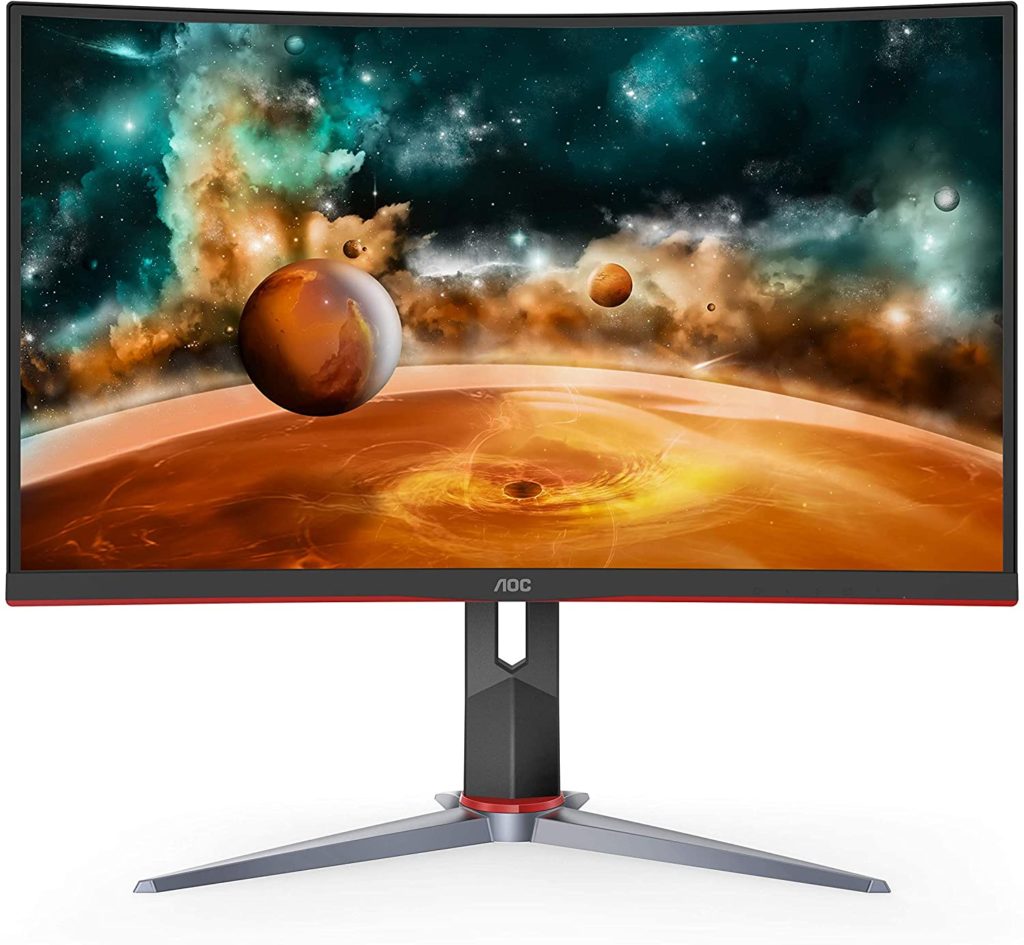
Our top pick for the best gaming monitor is the AOC CQ27G2 27″ Super Curved Frameless Gaming Monitor, which promises (and delivers) an incredibly responsive and immersive gaming experience thanks to its high contrasting curved VA panel that makes for lifelike colors and deep blacks. Coincidentally, it’s also the best 1440p 144hz monitor under $300 you’ll find today.
That’s a rare and precious gem especially at this price range. Plus, you’re also getting an exceptionally well designed screen with an ergonomic stand that is compatible with VESA mounts. Other amazing features include custom crosshairs, gamma curvature adjustability with Shadow Control, pre-calibrated photo presets, saturation presets, and MBR.
Having said that, one minor issue with this monitor is its relatively weak response speed, which means if the visuals are predominantly black, you might notice a bit of trailing with fast-moving objects, especially in high-speed games. However, that shouldn’t be a dealbreaker, especially considering all the other features and image quality you’re getting.
- 1440p resolution with wide color gamut
- Impressive pixel density and contrast ratio
- MBR and AMD FreeSync up to 144Hz
- Ergonomic design with curve panel
- Great value for money
Philips 278E1A 27″ Frameless Monitor
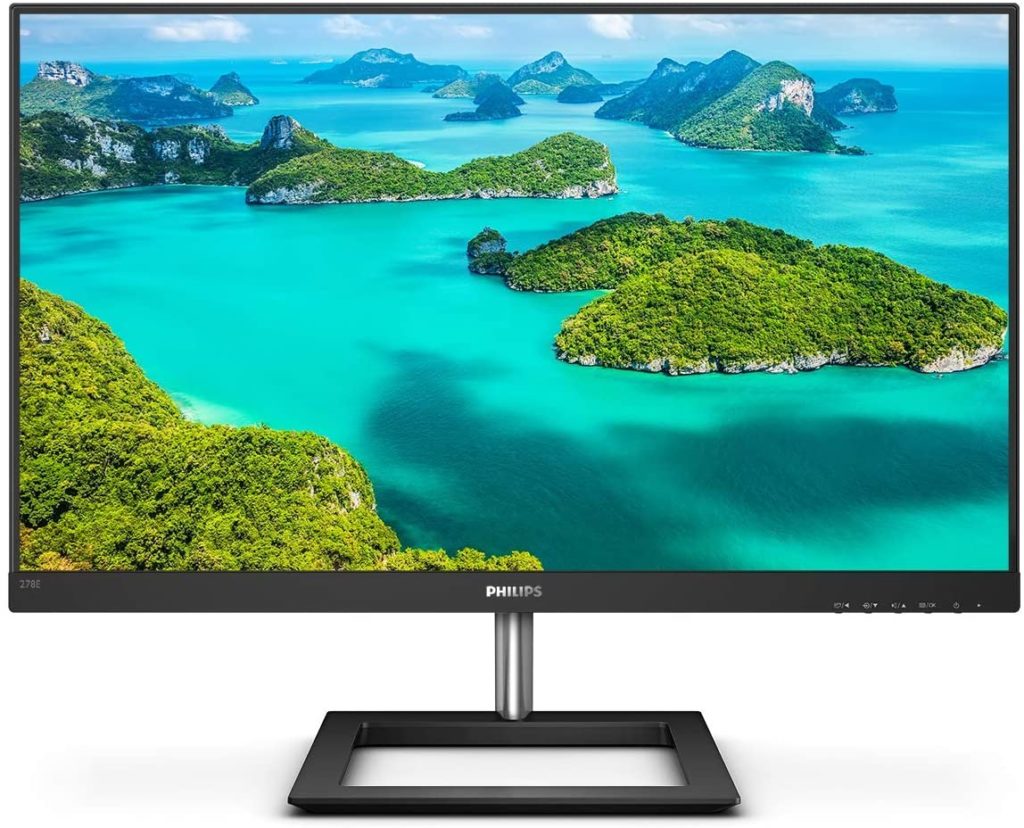
If you want the best 4K monitor under $300, look no further than the Philips 278E1A 27″ Frameless Monitor, which boasts of ultra HD resolution, unbelievably sharp pictures, crisp and vivid details, and so much more. You would have thought that it’s so-so since it’s suspiciously cheap for a 4K monitor, but it certainly lives up to our expectations.
For starters, its IPS panel features a 10-bit color support, 350-nit peak brightness, 109% color space (sRGB) coverage, and 1000:1 contrast ratio. What all these numbers mean is that you’re getting incredibly crisp and sharp pictures with accurate, vibrant, and lifelike colors. In other words, it’s great for gamers, and perfect for designers.
One thing to think about is whether your hardware configurations can handle the demands of gaming at 4K resolution. Otherwise, you might have to lower your picture settings when playing certain games. In any case, there’s zero need for anti-aliasing thanks to the incredibly high resolution, meaning, you’re sure to get a better frame rate performance.
- Wide viewing angles and sharp images
- Crisp image quality with vibrant colors
- Ultra thin bezels, VESA mount compatibility
- Multiple connectivity options
- Tilt-only stand
Asus VG278Q 27″ Full HD Adaptive Sync Gaming Monitor
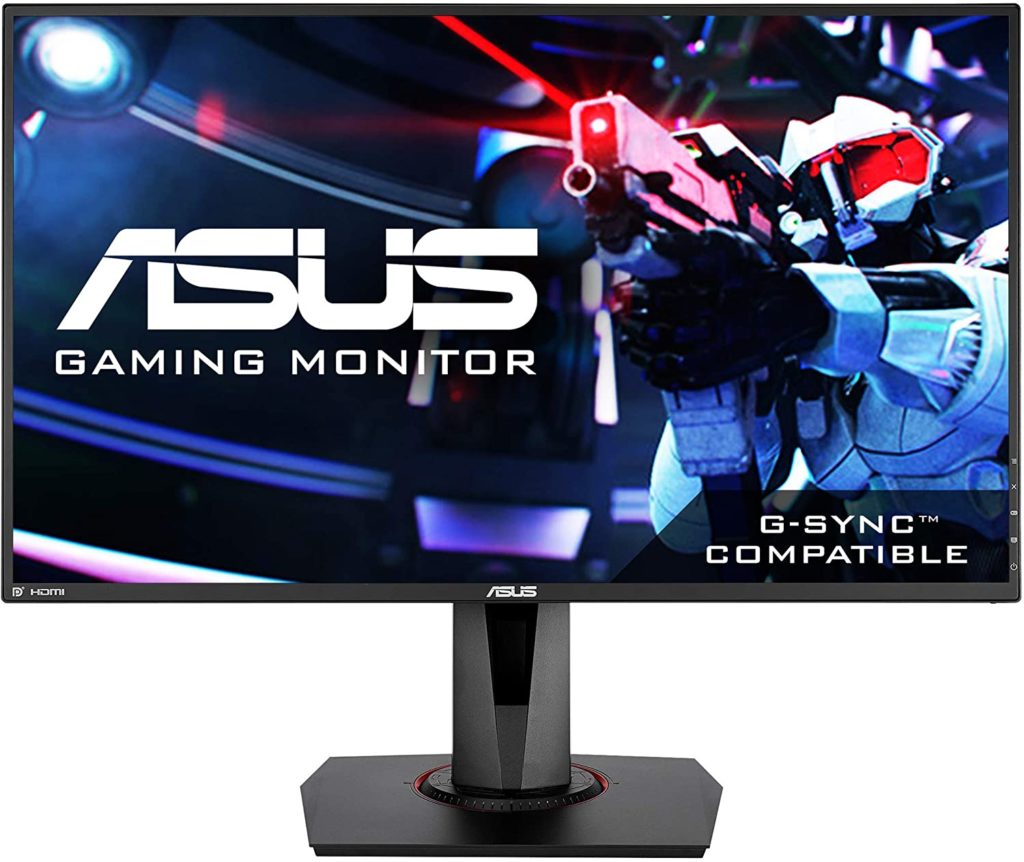
Another amazing choice for the best 144hz monitor under $300 is the Asus VG278Q 27″ Full HD Adaptive Sync Gaming Monitor, which delivers a superb gaming experience without fail. Trust us, even the most avid and competitive gamers are sure to love this model, which probably has to do with the fact that it’s loaded with winning features.
One of the many things to love about this budget gaming monitor is its build quality. Not only does it look amazing with its mix of futuristic, sporty, and mechanical features that’s sure to stand out, it’s also durable, tough, and sure to withstand the rigors of everyday gaming.
More than that, you’re getting so many other extras that really up the ante in terms of functionality and user convenience, such as built-in speakers that deliver superior sound quality, a multitude of connectivity ports including DVI-D and HDMI, and most importantly, G-sync technology that eliminates screen tearing and guarantees a fast and smooth gaming experience.
- Zero screen tearing with G-sync
- Minimized lag with 1ms response time
- Better motion with 144Hz frame rate
- Improved versatility with connectivity ports
- Immersive stereo sound with built-in speakers
Sceptre 30-inch Ultra-Wide Curved Gaming Monitor
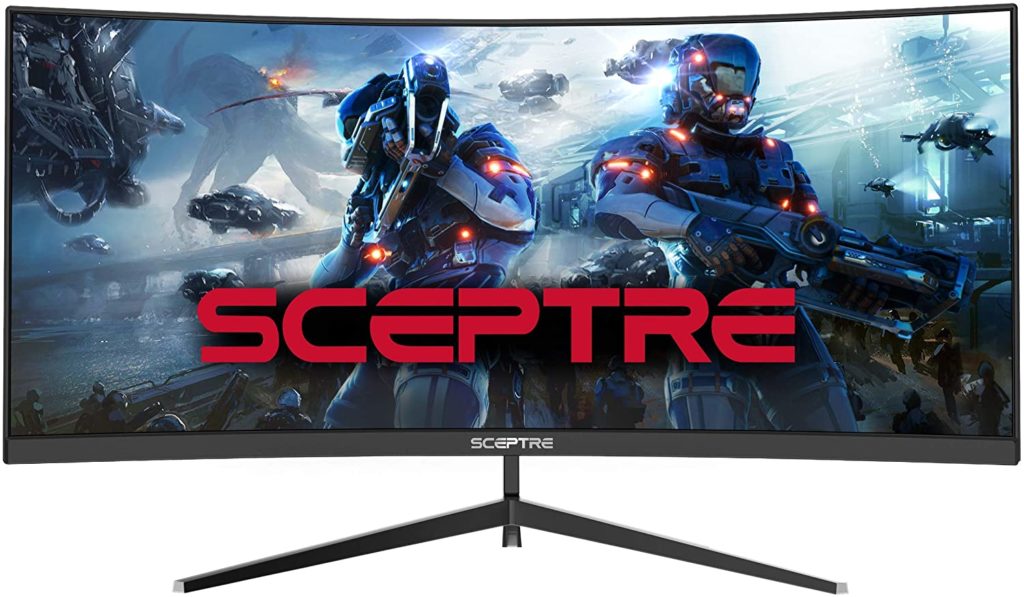
For the biggest, widest, and best in terms of frame rate, be sure to check out the Sceptre 30-inch Ultra-Wide Curved Gaming Monitor. With 30 inches of ultra wide and ultra slim display and 2560 x 1080 pixels of full HD resolution, this unit from Sceptre is easily one of the best 1080p gaming monitors available on the market.
It’s best asset is its superior 200Hz refresh rate, along with its high contrast ratio. Now, this makes for some truly impressive gameplays, but if your favorite game doesn’t want to play, lowering the frame rate to 144Hz will also give you a pixel response time that’s realistic and won’t create bottleneck issues. Meaning, whether at 200 or 144, you’re getting good visuals.
Not only that, you’ll also enjoy pre-calibrated photo presets, vivid dark and bright tone relations, truly deep blacks, AMD FreeSynch support, stable G-sync performance, 3000:1 static contrast ratio, a DisplayPort range of 48-200Hz, and 90% sRGB color gamut. While these specs won’t make for popping and vibrant colors, you’ll still enjoy immersive visuals, so it’s a win for us.
- Immersive gameplay with curved screen
- High resolution and contrast ratio
- Smooth motions and tear-free gaming
- Incredibly detailed visuals with 200Hz refresh rate
- Instant sound with built-in speakers
Acer Nitro VG271 Pbmiipx 27 Inches Full HD IPS Monitor

If a 30-inch screen is a bit much for your desk space, let’s go a little smaller with the 27 inch gaming monitor. Manufactured by one of the best laptop and monitor brands in the world, this visual machine manages to be affordable while delivering some truly superior and elite-class specs and features.
It’s favored by esports gamers due to its appealing screen that boasts of a sleek frameless design and comes with a robust stand. More importantly, it features an IPS panel with a 144Hz frame rate and 1080p resolution, which, either individually or altogether, is a rare find at this budget-friendly price point.
Now, the visuals aren’t the sharpest with the Acer Nitro, but the vibrant colors and bright images more than make up for that shortcoming. The 99% sRGB alone is plenty enough when it comes to gaming purposes, and you’re sure to get consistent views without color-shift from any angle thanks to the IPS panel. Simply put, it’s a great gaming monitor at an even greater price.
- Excellent viewing angles with IPS panel
- Bright and vibrant visuals for esports
- FreeSync compatible, VESA certified
- Best value for money
BenQ MOBIUZ EX2510 24.5 Inch Gaming Monitor
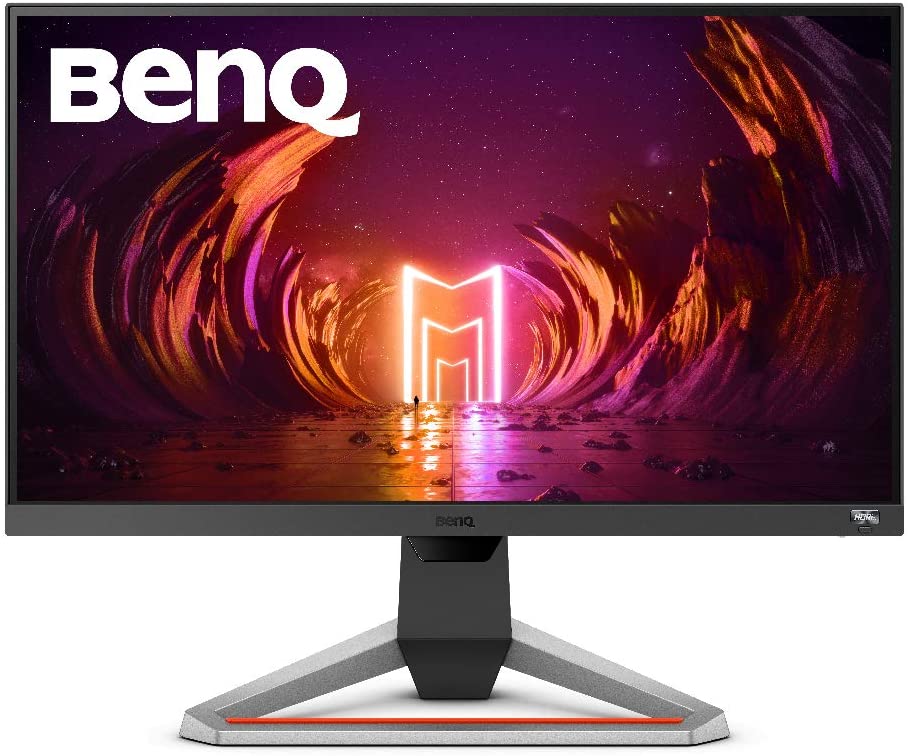
This next one is our smallest monitor yet, but what the BenQ MOBIUZ EX2510 24.5 Inch Gaming Monitor lacks in screen size, it undoubtedly makes up for in features and performance. We’re talking about wide viewing angles, vibrant colors, IPS technology, and so much more.
To expand on that, the 178 degree horizontal and vertical viewing angles are sure to deliver a totally immersive viewing experience, and with the consistent and accurate color reproduction, the imagery is sure to be amazing. There’s also zero risk of noticeable ghosting or motion blur even when playing fast-paced PC games, again thanks to the fast IPS panelling.
But, here’s the thing: it’s a 1080p monitor with a 144Hz refresh rate, so in those categories, it’s by no means the best. That said, the BenQ MOBIUZ is perfect for those who don’t have a particularly strong PC configuration and won’t be able to smoothly run games at 144Hz with a higher resolution.
- Accurate colors and immersive visuals
- Minimal input lag and fast response time
- MBR and FreeSync up to 144Hz
- Ergonomic design, sturdy build
Asus VP28UQG 28″ Monitor 4K/UHD
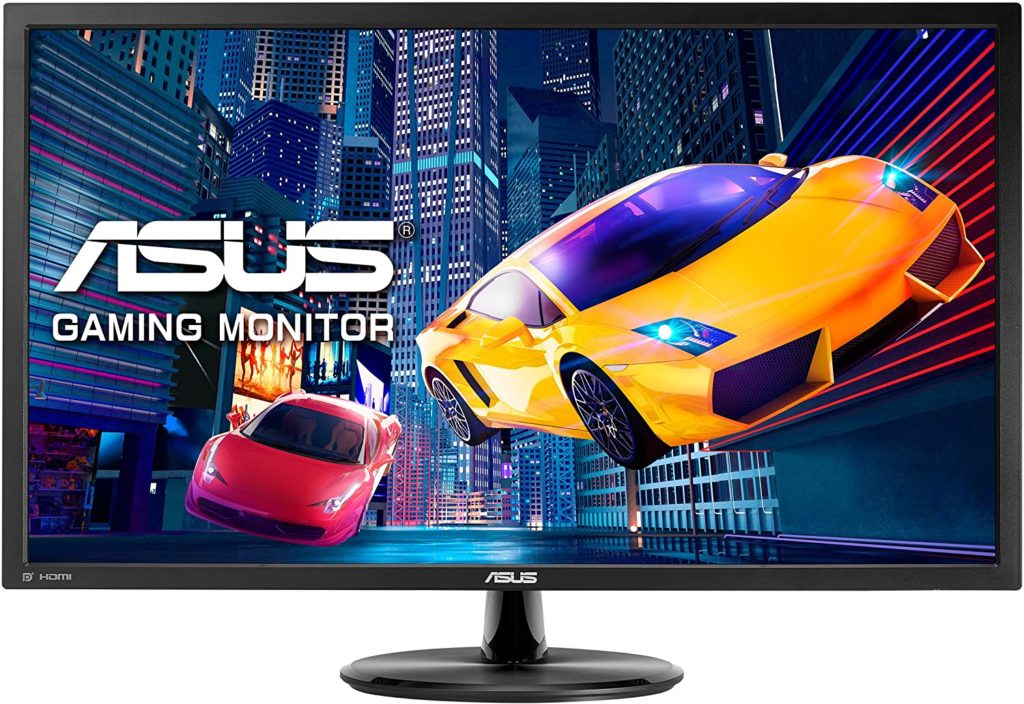
Finally, another option from Asus is the Asus VP28UQG 28″ Monitor 4K/UHD, which promises an extraordinarily amazing gaming experience thanks to photo-realistic visuals that rivals what its top competitors can offer.
The sizable 28 inch screen boasts of 4K (3840×2160) ultra HD resolution, something that most gamers can only dream of. The superb visuals that such resolution can produce is further enhanced by the Adaptive Sync, which makes for fast, smooth, visually rewarding visuals throughout each gaming session.
The icing on the cake are the plethora of connectivity options, including the two HDMI 2.0 ports for ultra HD playback, and the DisplayPort 1.2. Your eyes will also deeply appreciate this budget gaming monitor’s low blue light feature that maintains light visuals so your eyes won’t feel stressed or strained even after playing for hours on end.
- Intuitive monitor controls
- 5-way OSD Joystick inclusion
- GamePlus and other features
- Multiple connectivity ports
Don’t forget to protect your hands and wrists with the best gaming gloves so you can enjoy your next whole-day gaming marathon in comfort.
Budget Gaming Monitor Buying Guide
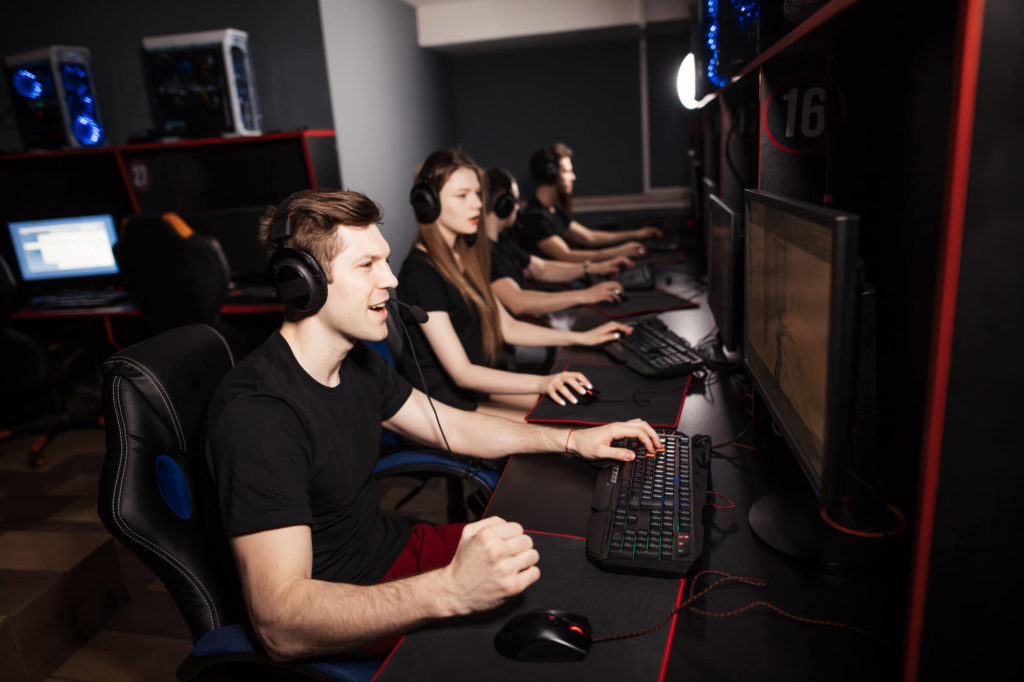
The desktop computer has come a long way since it was first invented decades ago. One of the most important components, of course, is the monitor. Today, computer monitors come in a wide variety of screen sizes, display resolutions, build qualities, and other specs.
The best in class? Gaming monitors. These come with ultra high resolutions and refresh rates, along with other features such as anti-ghosting, adaptive sync, and anti-tearing to make for the smoothest and fastest visual experience while playing intense games.
If you want to find the best gaming monitor in 2021, here are the things you need to consider:
Screen Type
To put it simply, a computer monitor is the output device displaying the data flowing from the PC through a video or graphics adapter. But, this information transfer and display process varies depending on the type of monitor you’re using, and consequently, the quality of images you can see on the screen.
Cathode Ray Tube (CRT)
The first ever monitors introduced on the market were CRT monitors, which make use of electrons to display visual elements. Initially, CRT monitors were only able to output black and white images, before eventually moving on to color. Nowadays, you’ll very rarely see any CRT monitor, primarily because these are big, bulky, and heavy.
Liquid Crystal Display (LCD)
As CRT displays became obsolete, we saw a lightning-fast growth of LCDs, which are flat, thin, and lightweight monitors containing liquid plasma and fluorescent backlighting to illuminate and display images. Up to this day, LCD monitors can be seen in many homes and offices.
Light Emitting Diodes (LED)
An even more technologically advanced type of computer and TV monitor is the LED screen, which utilizes light emitting diodes and passing current to produce clear and sharp images. As compared to LCDs, LEDs are thinner, lighter, and more energy efficient.
Organic Light Emitting Diode (OLED)
You might also see OLED monitors, which by far is the latest in terms of monitor technology. These displays come with electroluminescent diode layers made with organic components. The images you see on screen are produced by the light that’s generated through said diodes. When the screen is off, what you’re left with is a transparent screen that may be flat or curved.
Touchscreen
Finally, there are also touchscreen displays, meaning, their interface is touch-sensitive, which allows users to better interact with the computing and display system. Essentially, these are like the screens on your smartphones and tablets, though many gaming laptops under $1500 also come with touchscreen displays now.
TN vs IPS vs VA
Another thing to consider on the subject of screen types is the technology used in the display panel, aka whether it’s TN, IPS, or VA. Here’s what you need to know:
An IPS panel offers better viewing angles and color reproduction than TN monitors, making them a great choice for single player games, movie streaming, and video editing. However, you’re losing out on competitive gaming due to lower refresh rates and response times (unless you get a costly, high-end IPS display). In this case, TN screens have the advantage.
Meanwhile, a VA panel will offer a balanced combination of decent response times and good viewing angles, along with true, deep blacks and excellent contrast ratios. That said, many still prefer standard IPS panels and TN panels with high refresh rates than VA panels, so that’s something to think about.
Screen Size
You’ll also need to decide on the screen size. Generally speaking, the bigger, the better, especially when it comes to gaming and if you want to enjoy immersive visuals. However, that may not always be the case.
For instance, while bigger monitors make for more precise, prominent, and immersive visuals, which translates to thrilling gameplays and an extraordinary overall experience, these oversized monitors are also more expensive, and naturally, they take up considerable desk space.
So, if you are working with a tighter budget or have to work around limited space, you might have to make do with a smaller screen, which isn’t always a bad idea, mind you. Think of it this way: you’re at most two feet away from the screen, and as such, you’ll hardly notice details far from the center of the display anyway.
Resolution
More important than the screen size is the resolution, which ultimately determines image quality. Nowadays, you have a wide range of choices when it comes to resolution, from near-obsolete HD ready displays to the dreamy 4K or ultra HD. contrary to what you may think, however, a higher resolution display isn’t always ideal, especially when it comes to gaming.
That’s because while 4K screens offer incredibly detailed visuals, you’re typically compromising on refresh rates, so you might experience a lot of lag especially when playing fast-paced games. Besides, 4K monitors are quite expensive and hard to find at the $300 price point.
Instead, consider 1080p or 1440p gaming monitors. If you have a relatively weak CPU and GPU, you’ll get a better and more consistent visual performance with a 1080p display, but if your gaming rig can handle increased resolutions without encountering any issue, by all means invest in the best 1440p gaming monitor under $300 that you can find.
Pixels per inch (PPI)
There’s also the matter of PPI or pixels per inch, which is determined by the combined factors of screen size and resolution. Basically, a smaller monitor with a higher resolution will produce sharper images and smoother lines than a bigger monitor with a lower resolution, simply because all the pixels are packed more densely in a smaller space.
So, for example, you’re thinking of buying a 1080p monitor. You’ll get better visuals with a 24 inch screen than with a 30 inch, and you’ll be able to easily see and distinguish details from afar because of the higher pixel density. This is better on the eyes since you don’t have to squint or lean too close to the screen to see what’s going on.
Ultrawide vs Widescreen
In relation to the resolution is the format of the display, which these days is really just either widescreen or ultrawide. You won’t find any of those old 3:4s nor movie theater panoramas. It’s all good, though, and here’s why:
Widescreen formats are the most common on gaming, computer, and TV monitors today, and most games are designed to run on such a format. So, you won’t encounter any display issues, stretching, cropping, or excessive black borders.
However, ultrawide monitors are also a good idea, especially if you also want to watch lots of movies, since the 21:9 format is highly similar to the native 2:39:1 movie aspect ratio, or if you do lots of multitasking, web surfing, and other day-to-day activities on your desktop PC, since the added bit of horizontal space can double as your working space.
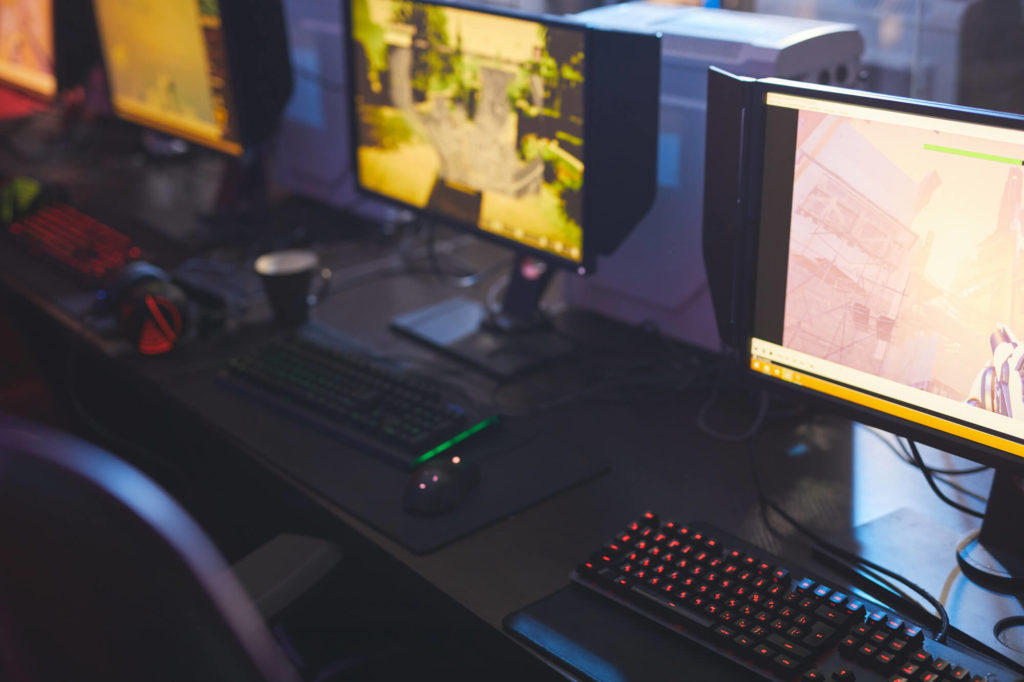
Refresh Rate
We’ve been dropping the term ‘refresh rate’ several times now, so let’s talk about what it means and why it’s important. Basically, refresh rate is the frequency at which the screen is able to update or refresh the display based on any change that may have occurred. This rate is measured in Hz (hertz), and so the more often the screen is refreshed, the higher the Hz is.
You might have noticed numbers like 60Hz, 144Hz, or 200Hz as you were looking at gaming monitors. What these numbers signify is the monitor’s speed or refresh rate. Higher refresh rates create a much smoother visual experience instead of something that looks like a stop motion animation.
This also has to do with the fact that a refresh rate of 144Hz, as compared to, say, 60Hz, is close to our eyes’ real-life ‘refresh rate’ and how we perceive real-life motion. What this means is that with a 144Hz screen, you get to enjoy quicker reactions, better visuals, and a greater overall experience. Of course, that only works if the CPU and GPU can handle such demand.
Adaptive Sync
One common issue that arises with the disparity between your monitor’s frame rate, the capabilities of your hardware, and the demands of your game is screen tearing and lag. If you want to avoid this and enjoy a much smoother gameplay, look for gaming monitors that feature AdaptiveSync technology.
Read more about refresh rates here.
Response Time
While refresh rate is how often the screen changes the image or image details on screen, response time deals with how fast the monitor transitions from any particular color to another, or as some would say, how fast the monitor responds to input.
Contrary to refresh rate where you want higher numbers like 200 or even 240Hz, when it comes to response time, you want it to be as low as possible. 5 ms is widely acceptable for most visual related activities like movie watching and gaming, but for a more competitive gameplay, you might want to consider a lower response time, say 1 ms, which reduces any perceivable lag.
Color Reproduction
Moving on, let’s talk about color reproduction, color gamut, or color space, which roughly refers to the panel’s ability to display colors. In essence, what you want here is a wider color gamut or a higher color space percentage, which gives you better, more vibrant, more accurate, and more life-like colors.
You’ll see that the color space support is listed as a percentage number with an acronym, usually being sRGB or DCI-P3. The best gaming monitors, then, are those that are listed as 100% sRBG, 100% Adobe-RGB, or 100% DCI-P3 color space.
Ergonomics
Finally, there’s also the issue of ergonomics, which affects your viewing comfort especially when using the computer for long periods of time. Actually, gaming laptops have the advantage over desktop PCs in terms of ergonomics for the simple reason that you can tilt, twist, turn, and flip your screen to just about any angle you desire.
You can even lay down on your bed, place the laptop beside you or hold it above, etc. One thing that can give you some of this versatility is the ergonomic features of the PC monitor, which usually has to do with adjustable heights, left and right swivel, and front or back tilt.
It’s not quite the same as what you get from a laptop, but it’s certainly better than nothing, especially with the added comfort of an affordable gaming chair under $100.
FAQs
Is FreeSync or GSync worth it?
You’ll notice that many gaming monitors typically come with the AMD FreeSync feature, or in the case of NVIDIA, G-sync. These two variable refresh rate technologies allow you to manipulate the monitor’s refresh rate to your liking, which eliminates stuttering and screen tearing within your selected dynamic range. However, it’s only possible if you have a compatible GPU.
Some gamers would argue that G-sync performs better than FreeSync, but there are quite a few downsides with the NVIDIA VVR tech as well. For instance, it’s certainly not free, which means you have to shell out extra bucks for it, and it’s also harder to find suitable graphics cards that can support the technology (you need one with DisplayPort 1.2a).
One silver lining is that if ever you decide to upgrade, it is now possible to use G-sync on a FreeSync monitor.
Which is best- 1080p, 1040p, or 4K?
The truth is, 4K monitors are too demanding on the CPU and GPU, so unless you’re sure that your workstation can handle it, limit your 4K dreams to your family room TV for immersive movie marathons. For gaming purposes, a somewhat lower resolution will better ensure that you don’t have to lower picture settings or compromise your frame rate.
That said, the choice of which resolution is best largely depends on the kind of games you like to play. For games that are graphically oriented, 1440p 60Hz is ideal, but for competitive games with first-person shooters, a 1080p 144Hz gaming monitor will serve you better. Of course, the most versatile would be a 1440p 144Hz screen.
Conclusion
Your monitor plays a huge part in your gaming rig’s performance and influences the dynamics of your workstation. Ultimately, the best gaming monitor under 300 dollars is one that is pleasing and comfortable to look at for extended periods of time, and more importantly, is able to consistently and reliably deliver superb graphics and visuals.
And, as long as you know what to look for and how to evaluate your needs and desires, you can easily find a gaming monitor that works for you.






